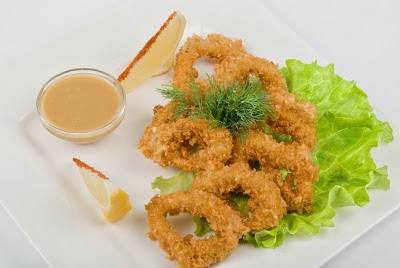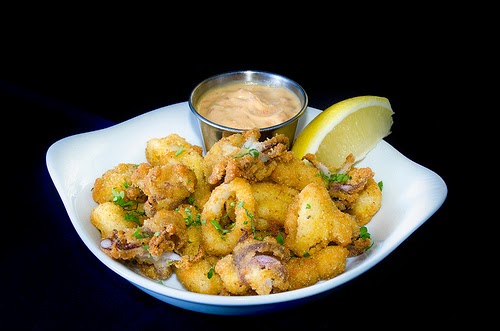Calmar
Frit, Sauce Marie-Rose.
Deep-fried
calamari with French Cocktail Sauce.
Photograph
by rusak/YayMicro.com.
Calmar, Calamar or Encornet in France – Calamari, and squid in
English.
Calmar (calamari) is tremendously popular in France
and not only on seafood restaurant menus. Calamari in France will be on
restaurant menus grilled, baked, stuffed, and or stewed. Very small calamari are called petit-calmar
or chipirons, and there is a unique small calamari called an encornet. Very small calamari maybe only 3 to 4 cms
(1.5” long) and will have their own recipes designed for them.
The largest calamari on any menu, before being cut
into small circles and pieces, will have been, at the very most, 30 to 40
cms (12” – 15”) long. Larger calamari
will be thrown back or become cay food. Monster squids, those that may be seen
on the National Geographic channel, will not be part of any fisherman’s or
fisherwoman’s catch. Calamari, when
cooked correctly, is mild and tender.
Your menu may offer:
Calamar Farci de Ris de Veau et Épinards – Squid stuffed with veal sweetbreads and spinach.
Lightly
fried calmars (calamari).
www.flickr.com/photos/bunchedup/2067844109/
Calmars Frits Sauce Marie-Rose – Deep-fried calamari rings served with the European lightly-spiced cocktail sauce. Deep-fried calamari, like elsewhere, is the favorite calamari dish in France. The beloved French seafood cocktail sauce is called Marie-Rose and is nothing like the North American cocktail sauce, which is heavy on the horseradish. A Sauce Marie-Rose is much milder, just fresh mayonnaise, tomato ketchup, Worcester sauce, or a dash of Tabasco. Occasionally a chef may add a touch of Cognac or Armagnac.
Calamari
With Sauce Marie-Rose.
www.flickr.com/photos/nwongpr/8354723469/
Risotto à l’Encre de Seiche et Calamars – Risotto, prepared with the ink from both cuttlefish and calamari. Cuttlefish called seiche in French, and calamari both have dark inks with slightly different flavors. The ink that will be used for the dish on your menu shows the chef's personal preferences, in this case, both.
Calamars Sautés à la Provençale et sa Purée à l'Encre de Seiche – Calamari fried in the manner of Provence and served with mashed potatoes flavored and colored with cuttlefish ink. For seafood prepared in the manner of Provence, the calamari will be fried in olive oil with tomatoes and flavored with garlic.
Calamari, cerignola olive
& tellicherry
peppercorn gremolata,
(The Cerignola olive is a very large, mild, Italian olive).
www.flickr.com/photos/stuart_spivack/2979255108/
Small calamari on the menu.
The French names used for small calamari are
encornets or petit-calamars; they are called chipiron in France's Basque
country, t Pays Basque. However, do not be surprised that the names used change
with the area you are visiting.
Casserons are tiny cuttlefish and are often confused with tiny
calamari. Worry not; you will not taste
the difference, and these tiny cuttlefish may be on another menu as supies,
supions, sépiole, or sépion.
Chipirons aux Champignon sà la Plancha. – A particular small squid cooked with mushrooms on a plancha. A plancha, in the Basque language, is a planxa; it is a very thick metal slab that is used in traditional Southern French and Basque restaurants to achieve a taste somewhere between grilling and frying.
Petit-Calmars à la Plancha, sur un Lit de Pâtes à l'Encre - Calamari cooked on the plancha and served on a bed of pasta cooked in calamari’s ink.
The encornet on
French menus
The encornet is a highly prized small squid with its
own recipes. When cooked, I acknowledge that you cannot identify an ecornet by
sight; I can only advise you to sit down and enjoy it.
Friture d'Encornet à la Fleur de Sel et son Chutney de Tomate – Lightly fried encornets sprinkled with Fleur de Sel and served with a tomato chutney. Fleur de Sel, the flower of salt, a dried sea-salt from the salt crystals on the very top of the salt pan;
Chilled pan-fried encornet, couscous
www.flickr.com/photos/stuart_spivack/3290891027/
Salad Tiède d'Encornets Farcis au Caviar d'Aubergine – A warm salad of encornets stuffed with eggplant caviar.
Calamari and cuttlefish ink.
Calamari
and cuttlefish and octopus have a black ink that is used in the sea
as a smoke screen to escape predators. In a restaurant’s kitchen, the ink is
used to color and flavor sauces for other seafood dishes. Calamari and
cuttlefish ink, encre noir, are the most popular.
Confusion with the French names of
calamari and cuttlefish.
Do
not be surprised that calamari, baby calamari and baby cuttlefish will be found
under a variety of names in different parts of France. Fishermen and
women never respected borders and France’s borders have historical connections
with the many languages. France, Spain, and Italy have long interconnected
histories and language influences.
In
the
French Basque country, the Pays Basque, which up against the Pyrenees, you
will hear Basque spoken all the time. Then part of ancient Catalonia is in the Occitanie
region of France and so part of France’s population has Catalan as a second
language. France also borders Andorra where the official language is Catalan.
To add to this tower of babel much of southern France has Occitan as a second
language along with Occitan dialects such as Provencal and Nicoise. Italian
influenced the Savoy departments and the
city of Nice was part of Italy until 150 years ago. Then in
areas close to the Italian border, you may hear Piedmontese, a language still spoken in the Italian region
of Piedmont next to France’s South Eastern corner. The
language of the Roma, French Gypsies, also provides additional input in
France’s south-west.
What’s the difference between
calamari, cuttlefish
and octopus?
Those
who have not yet tried calamari sometimes assume that calamari, cuttlefish and
octopus, are all variations on a theme; however, they are very different and
have different tastes and textures. They are not at all the same and apart from
tiny calamari and baby cuttlefish they will all be served with different
recipes. For the record squid and cuttlefish both have ten tentacles or feelers
while an octopus has eight tentacles.
Squid, Calamar, Encornet, or Calamari in the languages
of France’s neighbors
(Catalan
- calamar), (Dutch - pijlinktvis), (German – kalmare), (Italian – calamaro or
calamari), (Spanish – calamares). (Latin - loligo vulgaris).
--------------------------------
Behind the French Menu
by
Bryan G. Newman
behindthefrenchmenu@gmail.com
Copyright 2010, 2012, 2015, 2020
--------------------------------
Searching for the meaning of words, names or phrases
on
French menus?
Just add
the word, words, or phrase that you are searching for to the words "Behind
the French Menu" (best when including the inverted commas), and search with
Google, Bing, or another browser. Behind the French Menu’s links,
include hundreds of words, names, and phrases that are seen on French menus.
There are over 450 articles that include over 4,000 French dishes with English
translations and explanations.













